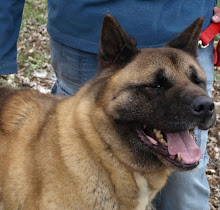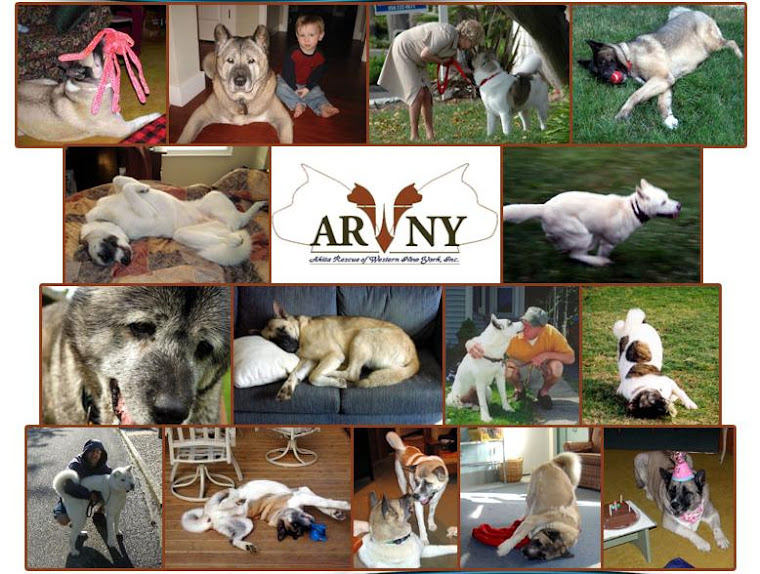
There has been a lot of discussion on the internet about a very sad situation with a little pitbull named OREO who was at the ASPCA in NY. I won't go too much into specifics but you can read the story here:
http://www.aspca. org/pressroom/ press-releases/ 111309.html
I will say this -- after 5 months of daily working with this little pit, who was so horribly abused by her 19 yr old owner (may he never have another moment's sleep or peace!) it was decided her human fear aggression issues were too severe to allow her to be safely rehomed. It had NOTHING to do with her breed, as the ASPCA saves thousands of pitbulls & rehomes them. It had NOTHING to do with BSL. It had EVERYTHING to do with her having "triggers" that incited aggression, with having no bite inhibition when it came to humans due to her fear, her abuse. I don't blame her, the story broke my heart, & I felt nothing but sadness & pity for Oreo. But I also would NOT have placed her with another rescue, in a sanctuary or in a new home. I know a dangerous situation when I see one.
The big hue & cry is that she should have been sent to "sanctuary", or to a no-kill facility or to another rescue, because many rescues were just SO SURE they could do what this facility failed to do after 5 months of the best possible behavior help available. Herein lies the problem for me -- I guess because I have too much common sense to just think that would have been a nice easy solution.
First, the term NO-KILL is a misnomer (wow I'm full of big words today!)because no shelter is truly NO-KILL despite what they say. Use your common sense -- if they truly did NOT kill ANY animal surrendered, how long do you think it would take for them to be TOO FULL to take in any more dogs until all these unplaceable dogs died a natural death? So, what they mean is, THEY don't kill the dogs themselves -- they just send them elsewhere to have it done for them. Hence, no such thing as a true no-kill shelter.
As for sanctuaries -- there are a few in this country with huge amounts of land, with big money behind them, that are well-run and can hold out hope for a VERY select few dogs that are social with other dogs but possibly not with humans. These dogs can be given big areas to run & play in together as a pack situation, with shelter, where no human has to come into direct touching contact with them; just goes in to feed, water & clean the big area, big enough so the dogs can move around & not be handled. Now, use your common sense again here. If every human-aggressive-but-social-with-other-dogs dog was sent to these places, how quickly would they fill up -- my educated guess is -- OVERNITE. Then once again, they would be full, have no room, so would be unable to take any MORE dogs to help since they are truly no-kill. So, in reality, they take very few new pets, they are very selective in who they take, and they don't get in over their heads. Those are the well-run places, of which there maybe only 4 or 5 in the whole country.
Then there are the poorly run but wonderfully advertised places with big-names & big advertising campaigns who make themselves out to be the wonderful saviors of THE SPECIFIC DOGS THEY PUBLICIZE no matter what its issues, that are called no-kill facilities also. What happens there is this -- pets that are human aggressive end up in a cage for the rest of their lives there while the other unknown/unadvertised pets that never got publicity go to a kill facility so they have room here. Unable to be held, petted, loved, touched, the ones they keep live in daily fear of the humans that must open their cage, rabies-pole them to get them to move so they can clean the run, feed them, water them. The poor dog is a prisoner, no contact with other pets & unable to be handled by humans. My common sense tells me, this is INHUMANE. I've been to some of these places -- some are BIG NAME, big money-makers and people donate to them without ever visiting them to actually SEE what goes on behind closed doors. Easier to donate than to actually SEE what happens, that's what our society is all about -- help from a distance & don't get your hands dirty. These places are inhumane and I will not ever allow any Akita in my care to be condemned to hell at places like this. Yet daily, weekly, monthly, I see people saying "Why wasn't such & such a place contacted to help this dog?" It drives me crazy.
Dogs sit in local shelters, dying for a home, yet posters all over the internet are working their butts off to save a dog 2,000 miles away -- then rescues from 2,000 miles away offer to take THAT one dog to save it, when dogs just like it are dying less than 2 miles away from their back door. Where is the common sense in that? Why has it gone down the drain? Common sense says -- if there are 100 dogs sitting in your local shelter & you have room, you help one of them. You don't go 2,000 miles away & spend time, HUGE money and effort to bring in one from across the country. When you do that -- it means a dog next door is condemned to death.
Can common sense work in rescue? When I started in rescue, it was what everyone I was associated with, who did good rescue, had in huge quantities. Lately I'm starting to think its gone the way of the Dodo bird -- its becoming extinct!! Common sense tells you to help those dogs close by that take less money, less time & can be helped safely & humanely, to get them into homes so less dogs die for lack of space in that same facility. Or common sense says, if you have room, take a dog in from one county over if there are NONE in your local shelters that you can help. But now -- now we have dogs from the south being brought to the north to fill our shelters, even from Mexico & Puerto Rico to become "unwanted" in the north, to force dogs FROM the north to be euthanized for lack of space (I know b/c I had to RESCUE an Akita brought as a puppy up from Puerto Rico who was adopted out then RETURNED unwanted to a northern NJ shelter b/c the rescue group that brings up these puppies doesn't take back "adults"!).
We have well-meaning but definately ill-conceived notions that a rescue from one part of the country should expend thousands of dollars in transport money, time & space to bring in a dog from another part of the country when exactly the same breed of dog is sitting in the HUNDREDS in their own state. I would never let an adoptable Akita near me die so I could bring in one from the south or any other part of the country. I have taken in Akitas from other areas but in doing so, NO local Akita to me died for that lack of space.
Sadly I do have to decide which Akita we can help sometimes when faced with two we need to consider -- the one with 6 bites on its record who has become so used to biting humans that it has become second nature & will NEVER be safely rehomed or at the very least, will sit for a year or two in our rescue waiting for just that ONE home up on a mountain with no company, no visitors & no other family who could possibly live with his issues -- or the sweet one further away that has bite inhibition & will be safely rehomed without biting someone just for the heck of it. Thats when common sense intervenes saying "you know exactly which Akita you need to save!" But if faced with saving two Akitas with the same issues from different areas -- I will always opt for saving the one in OUR region that I can help locally. I will not risk someone being bitten transporting a bite case, scaring the dog by sending it from driver to driver to get it to us here. Common sense prevails.
And worse, we have people who figure that EVERY DOG can find a home despite common sense saying "a dog that bites humans is NOT a safe dog to rehome when thousands of NICE dogs are dying all around you." Some dogs are just not safe to ever rehome -- period. Like it or not, there are psycho dogs out there - dogs so badly damaged that they cannot be safely rehomed. Just like with humans, dogs can also be mentally damaged beyond repair.
I was taught to do rescue using common sense factors. I had great mentors with great common sense. Yes my heart used to tell me to do one thing but my common sense intervened & helped me do the right thing. Of course I cry like a baby when I know I have to make a decision that means an Akita will have to be humanely euthanize. But I would cry even more & probably loose my mind if I let an Akita I KNEW had human aggression issues go to a home & it ended up hurting someone.
So in this case listed above, after carefully reading the whole story, I feel the ASPCA did the responsible thing, and humanely let Oreo go "Over the Rainbow Bridge" never to fear humans again, never to suffer or go crazy or feel terrified of something a human might do to set her aggression issues off again. I feel that is our responsiblity as rescuers. I feel that is common sense. In this case, I feel the ASPCA used commone sense. They gave her 5 months of rehab & behavior work. Most dogs in shelters get 5 days.
Lets all start using a bit of common sense & realize there are many more who are the same breed as OREO who perhaps CAN be quickly rehabbed b/c they aren't so badly abused to hate ALL humans, and lets concentrate on them. Lets look to our local shelters to see just who we can help locally. Lets pull that ole' common sense back out of the moth balls where its been hidden lately & start to use it in the rescue world. Lets spend what limited funds we all have in rescue wisely, on dogs that CAN be saved, on dogs that CAN be rehabbed and not waste it for months on end on dogs that are too badly abused to be salvaged or to transport dogs across the USA when we have dogs JUST THE SAME AS THIS ONE sitting locally begging for the chance to be saved. There needs to be more common sense in rescue work -- doing rescue work with your heart only does NOT work in today's world. Put your heart in 2nd place and let your brain be in first.
Oreo, run & play "Over the Rainbow Bridge" and hopefully you have found the humans there with you are kind, gentle & sweet so that you can start to love human beings. I am glad you are no longer scared, sad nor aggressive any longer.





